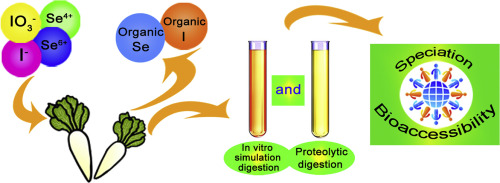当前位置:
X-MOL 学术
›
Food Res. Int.
›
论文详情
Our official English website, www.x-mol.net, welcomes your feedback! (Note: you will need to create a separate account there.)
Assessing bioaccessibility of Se and I in dual biofortified radish seedlings using simulated in vitro digestion.
Food Research International ( IF 8.1 ) Pub Date : 2018-10-16 , DOI: 10.1016/j.foodres.2018.10.049 Liang Hu 1 , Houbao Fan 2 , Daishe Wu 3 , Jinbao Wan 3 , Xianglian Wang 1 , Rongzhen Huang 2 , Wenfei Liu 2 , Fangfang Shen 2
Food Research International ( IF 8.1 ) Pub Date : 2018-10-16 , DOI: 10.1016/j.foodres.2018.10.049 Liang Hu 1 , Houbao Fan 2 , Daishe Wu 3 , Jinbao Wan 3 , Xianglian Wang 1 , Rongzhen Huang 2 , Wenfei Liu 2 , Fangfang Shen 2
Affiliation

|
Selenium (Se) and iodine (I) are essential elements for humans, and biofortification of vegetables with these elements is an effective way to amend their deficiencies in the diet. In this study, the distribution and transformation of Se and I species were investigated in radish seedlings that were simultaneously supplemented with these two elements; the fate and the bioaccessibility of Se and I species were dynamically surveyed in the oral, gastric and intestinal phases using a simulated in vitro digestion method. The radish seedlings were cultivated in hydroponic conditions with Se (IV), Se (VI), I- and IO3- (each 1 mg L-1). The results revealed that Se-methylselenocysteine (MeSeCys), selenocystine (SeCys2), selenomethionine (SeMet) and Se (VI) were present in radish, and MeSeCys was the dominant species in both gastric and intestinal extracts, comprising 32.7 ± 1.5% and 39.6 ± 1.1% of the total content, respectively. I- was also the dominant species, which accounted for 57.1 ± 2.1%, 46.6 ± 1.5% and 68.8 ± 1.8% of the total digested content respectively in the oral, gastric and intestinal extracts. Meanwhile, IO3- was absent and organic I accounted for approximately 20%. The bioaccessibility of Se and I in the intestinal phase reached 95.5 ± 2.5% and 85.8 ± 0.9%, respectively; although after dialysis through membranes, the data reduced to 60.1 ± 2.8% and 39.6 ± 0.8%, respectively. Contents of MeSeCys and I- increased from the oral to intestinal phase and the bioaccessibility of both Se and I in radish was above 85%. So radish is suitable as a potential dietary source of Se and I with biofortification.
中文翻译:

使用模拟的体外消化法评估双生物强化萝卜幼苗中Se和I的生物可及性。
硒(Se)和碘(I)是人类必不可少的元素,用这些元素对蔬菜进行生物强化是纠正其饮食中不足的有效途径。在这项研究中,研究了Se和I物种在萝卜苗中的分布和转化,同时补充了这两种元素。使用模拟的体外消化方法,在口腔,胃和肠道阶段对硒和碘物种的命运和生物可及性进行了动态调查。在水培条件下,用Se(IV),Se(VI),I-和IO3-(每个1 mg L-1)种植萝卜幼苗。结果表明,萝卜中存在Se-甲基硒代半胱氨酸(MeSeCys),硒代半胱氨酸(SeCys2),硒代蛋氨酸(SeMet)和Se(VI),而MeSeCys是胃和肠提取物中的主要菌种,分别占总含量的32.7±1.5%和39.6±1.1%。I-也是主要的种类,分别占口腔,胃和肠提取物中总消化含量的57.1±2.1%,46.6±1.5%和68.8±1.8%。同时,缺少IO3-,有机I约占20%。硒和硒在肠内的生物可及性分别达到95.5±2.5%和85.8±0.9%。尽管通过膜透析后,数据分别降至60.1±2.8%和39.6±0.8%。MeSeCys和I-的含量从口腔阶段到肠道阶段均增加,并且Se和I在萝卜中的生物利用度均在85%以上。因此,萝卜具有生物强化作用,适合作为硒和硒的潜在饮食来源。I-也是主要的种类,分别占口腔,胃和肠提取物中总消化含量的57.1±2.1%,46.6±1.5%和68.8±1.8%。同时,缺少IO3-,有机I约占20%。硒和硒在肠内的生物可及性分别达到95.5±2.5%和85.8±0.9%。尽管通过膜透析后,数据分别降至60.1±2.8%和39.6±0.8%。MeSeCys和I-的含量从口腔阶段到肠道阶段均增加,并且Se和I在萝卜中的生物利用度均在85%以上。因此,萝卜具有生物强化作用,适合作为硒和硒的潜在饮食来源。I-也是主要的种类,分别占口腔,胃和肠提取物中总消化含量的57.1±2.1%,46.6±1.5%和68.8±1.8%。同时,缺少IO3-,有机I约占20%。硒和硒在肠内的生物可及性分别达到95.5±2.5%和85.8±0.9%。尽管通过膜透析后,数据分别降至60.1±2.8%和39.6±0.8%。MeSeCys和I-的含量从口腔阶段到肠道阶段均增加,并且Se和I在萝卜中的生物利用度均在85%以上。因此,萝卜具有生物强化作用,适合作为硒和硒的潜在饮食来源。胃和肠提取物。同时,缺少IO3-,有机I约占20%。硒和硒在肠内的生物可及性分别达到95.5±2.5%和85.8±0.9%。尽管通过膜透析后,数据分别降至60.1±2.8%和39.6±0.8%。MeSeCys和I-的含量从口腔阶段到肠道阶段均增加,并且Se和I在萝卜中的生物利用度均在85%以上。因此,萝卜具有生物强化作用,适合作为硒和硒的潜在饮食来源。胃和肠提取物。同时,缺少IO3-,有机I约占20%。硒和硒在肠内的生物可及性分别达到95.5±2.5%和85.8±0.9%。尽管通过膜透析后,数据分别降至60.1±2.8%和39.6±0.8%。MeSeCys和I-的含量从口腔阶段到肠道阶段均增加,并且Se和I在萝卜中的生物利用度均在85%以上。因此,萝卜具有生物强化作用,适合作为硒和硒的潜在饮食来源。MeSeCys和I-的含量从口腔阶段到肠道阶段均增加,并且Se和I在萝卜中的生物利用度均在85%以上。因此,萝卜具有生物强化作用,适合作为硒和硒的潜在饮食来源。MeSeCys和I-的含量从口腔阶段到肠道阶段均增加,并且Se和I在萝卜中的生物利用度均在85%以上。因此,萝卜具有生物强化作用,适合作为硒和硒的潜在饮食来源。
更新日期:2018-10-16
中文翻译:

使用模拟的体外消化法评估双生物强化萝卜幼苗中Se和I的生物可及性。
硒(Se)和碘(I)是人类必不可少的元素,用这些元素对蔬菜进行生物强化是纠正其饮食中不足的有效途径。在这项研究中,研究了Se和I物种在萝卜苗中的分布和转化,同时补充了这两种元素。使用模拟的体外消化方法,在口腔,胃和肠道阶段对硒和碘物种的命运和生物可及性进行了动态调查。在水培条件下,用Se(IV),Se(VI),I-和IO3-(每个1 mg L-1)种植萝卜幼苗。结果表明,萝卜中存在Se-甲基硒代半胱氨酸(MeSeCys),硒代半胱氨酸(SeCys2),硒代蛋氨酸(SeMet)和Se(VI),而MeSeCys是胃和肠提取物中的主要菌种,分别占总含量的32.7±1.5%和39.6±1.1%。I-也是主要的种类,分别占口腔,胃和肠提取物中总消化含量的57.1±2.1%,46.6±1.5%和68.8±1.8%。同时,缺少IO3-,有机I约占20%。硒和硒在肠内的生物可及性分别达到95.5±2.5%和85.8±0.9%。尽管通过膜透析后,数据分别降至60.1±2.8%和39.6±0.8%。MeSeCys和I-的含量从口腔阶段到肠道阶段均增加,并且Se和I在萝卜中的生物利用度均在85%以上。因此,萝卜具有生物强化作用,适合作为硒和硒的潜在饮食来源。I-也是主要的种类,分别占口腔,胃和肠提取物中总消化含量的57.1±2.1%,46.6±1.5%和68.8±1.8%。同时,缺少IO3-,有机I约占20%。硒和硒在肠内的生物可及性分别达到95.5±2.5%和85.8±0.9%。尽管通过膜透析后,数据分别降至60.1±2.8%和39.6±0.8%。MeSeCys和I-的含量从口腔阶段到肠道阶段均增加,并且Se和I在萝卜中的生物利用度均在85%以上。因此,萝卜具有生物强化作用,适合作为硒和硒的潜在饮食来源。I-也是主要的种类,分别占口腔,胃和肠提取物中总消化含量的57.1±2.1%,46.6±1.5%和68.8±1.8%。同时,缺少IO3-,有机I约占20%。硒和硒在肠内的生物可及性分别达到95.5±2.5%和85.8±0.9%。尽管通过膜透析后,数据分别降至60.1±2.8%和39.6±0.8%。MeSeCys和I-的含量从口腔阶段到肠道阶段均增加,并且Se和I在萝卜中的生物利用度均在85%以上。因此,萝卜具有生物强化作用,适合作为硒和硒的潜在饮食来源。胃和肠提取物。同时,缺少IO3-,有机I约占20%。硒和硒在肠内的生物可及性分别达到95.5±2.5%和85.8±0.9%。尽管通过膜透析后,数据分别降至60.1±2.8%和39.6±0.8%。MeSeCys和I-的含量从口腔阶段到肠道阶段均增加,并且Se和I在萝卜中的生物利用度均在85%以上。因此,萝卜具有生物强化作用,适合作为硒和硒的潜在饮食来源。胃和肠提取物。同时,缺少IO3-,有机I约占20%。硒和硒在肠内的生物可及性分别达到95.5±2.5%和85.8±0.9%。尽管通过膜透析后,数据分别降至60.1±2.8%和39.6±0.8%。MeSeCys和I-的含量从口腔阶段到肠道阶段均增加,并且Se和I在萝卜中的生物利用度均在85%以上。因此,萝卜具有生物强化作用,适合作为硒和硒的潜在饮食来源。MeSeCys和I-的含量从口腔阶段到肠道阶段均增加,并且Se和I在萝卜中的生物利用度均在85%以上。因此,萝卜具有生物强化作用,适合作为硒和硒的潜在饮食来源。MeSeCys和I-的含量从口腔阶段到肠道阶段均增加,并且Se和I在萝卜中的生物利用度均在85%以上。因此,萝卜具有生物强化作用,适合作为硒和硒的潜在饮食来源。


























 京公网安备 11010802027423号
京公网安备 11010802027423号